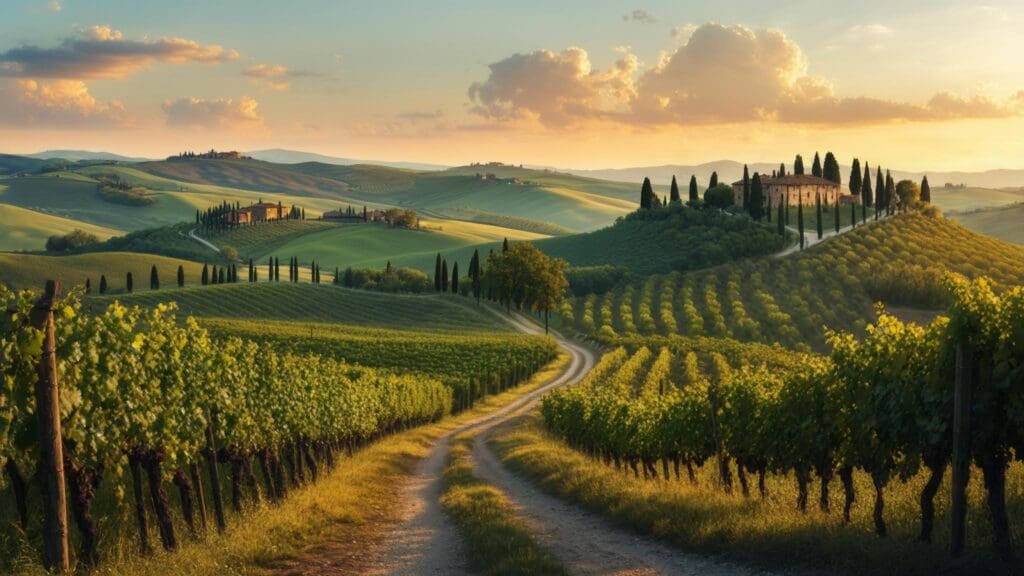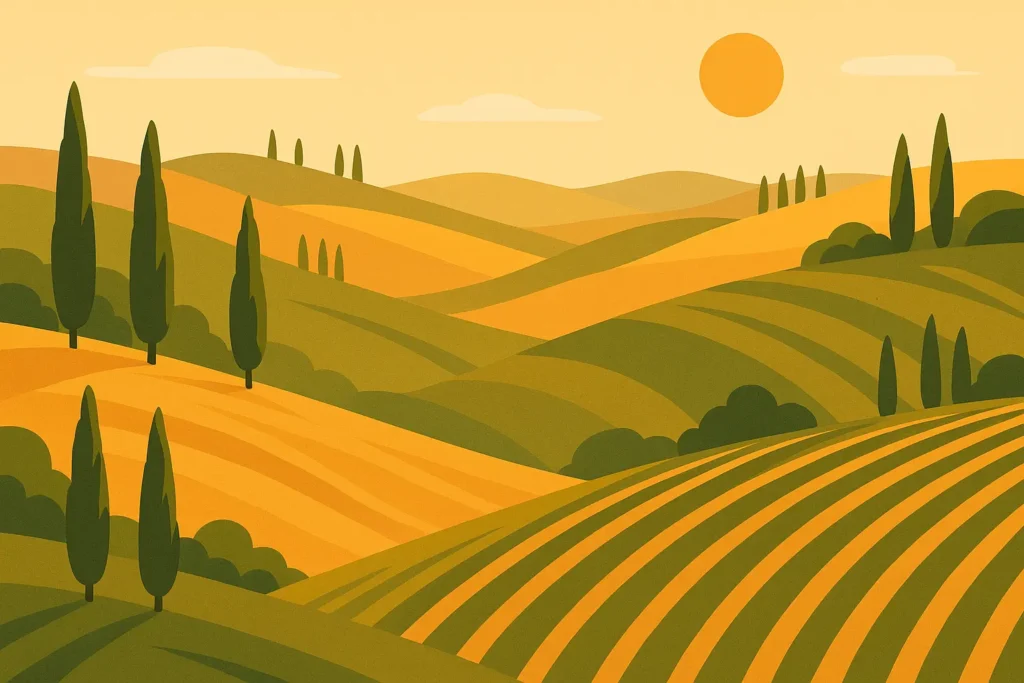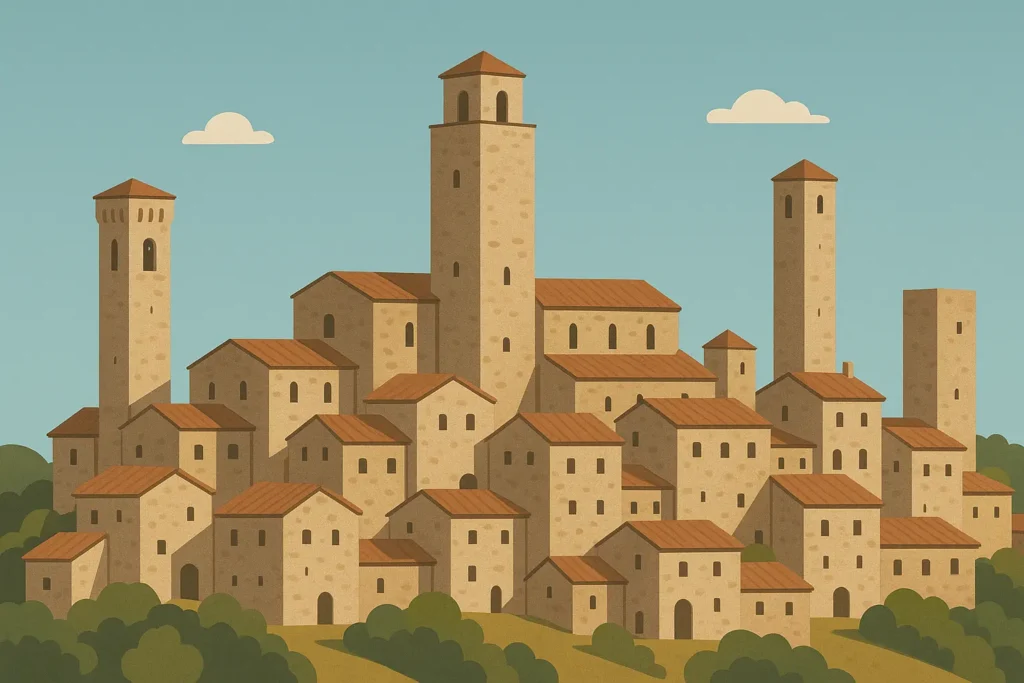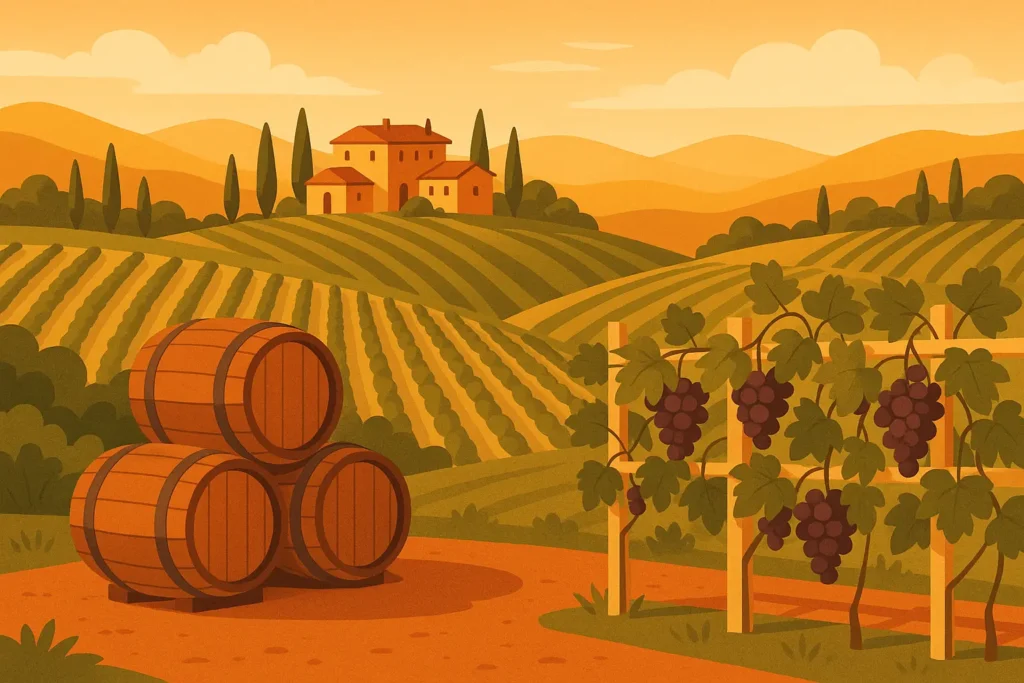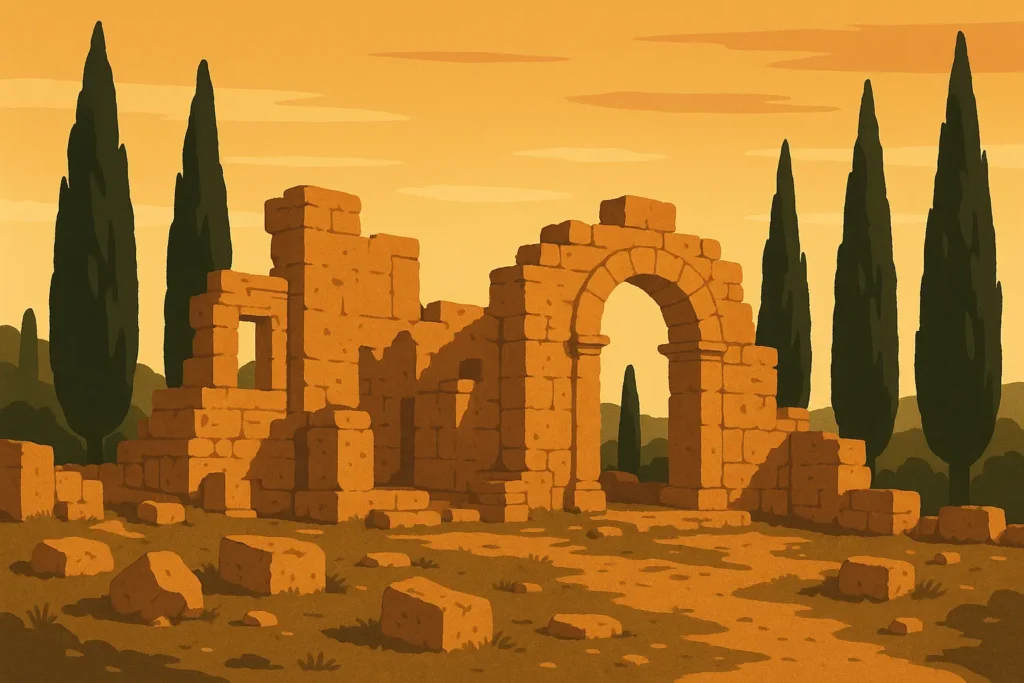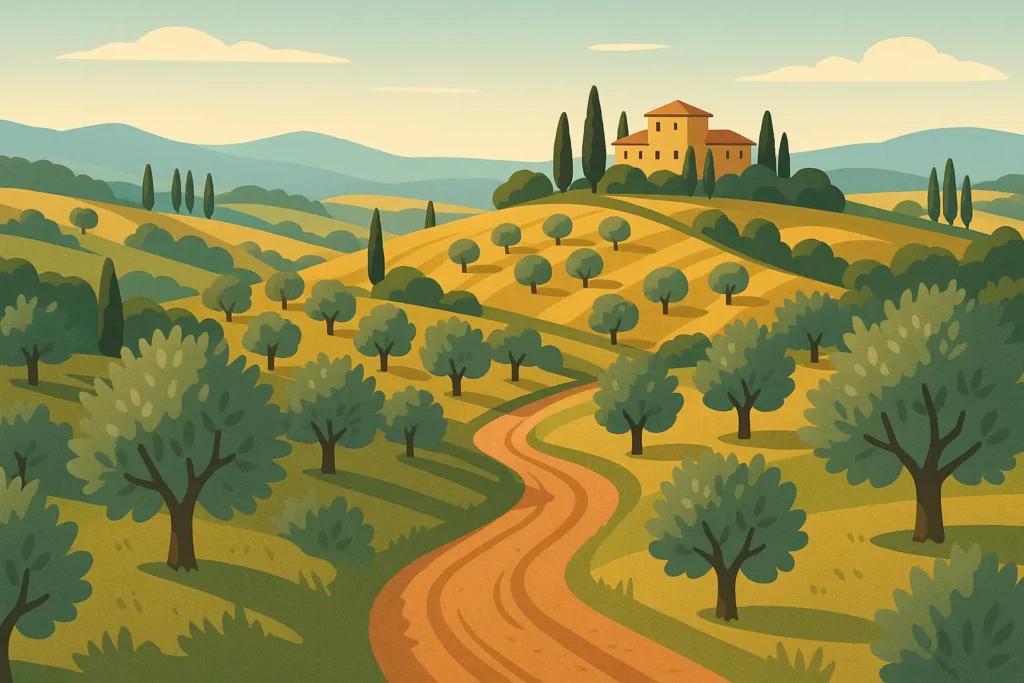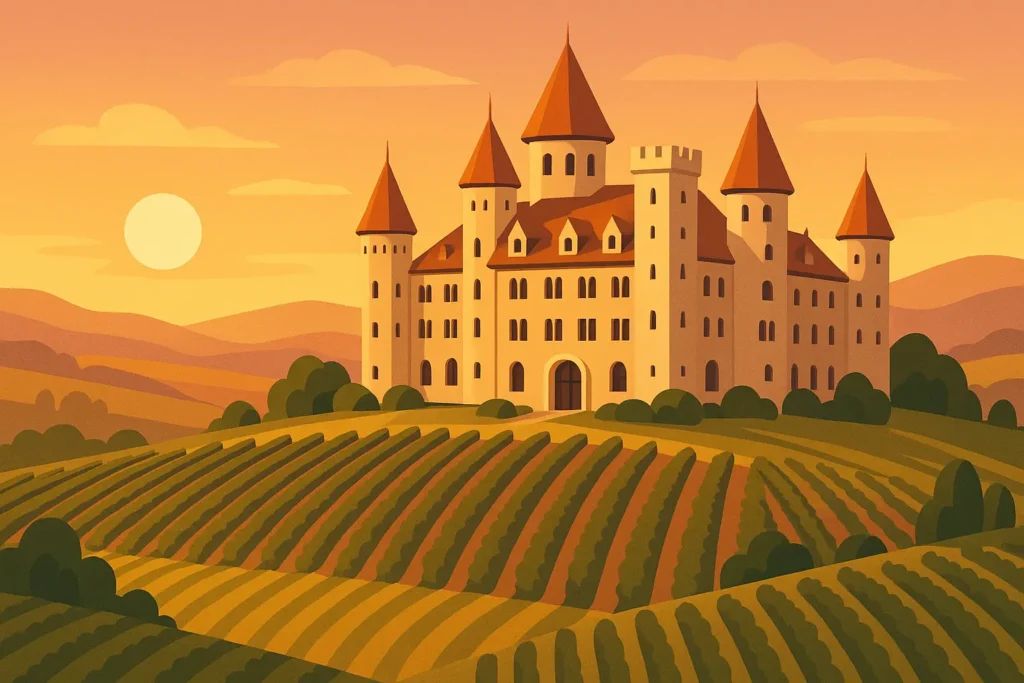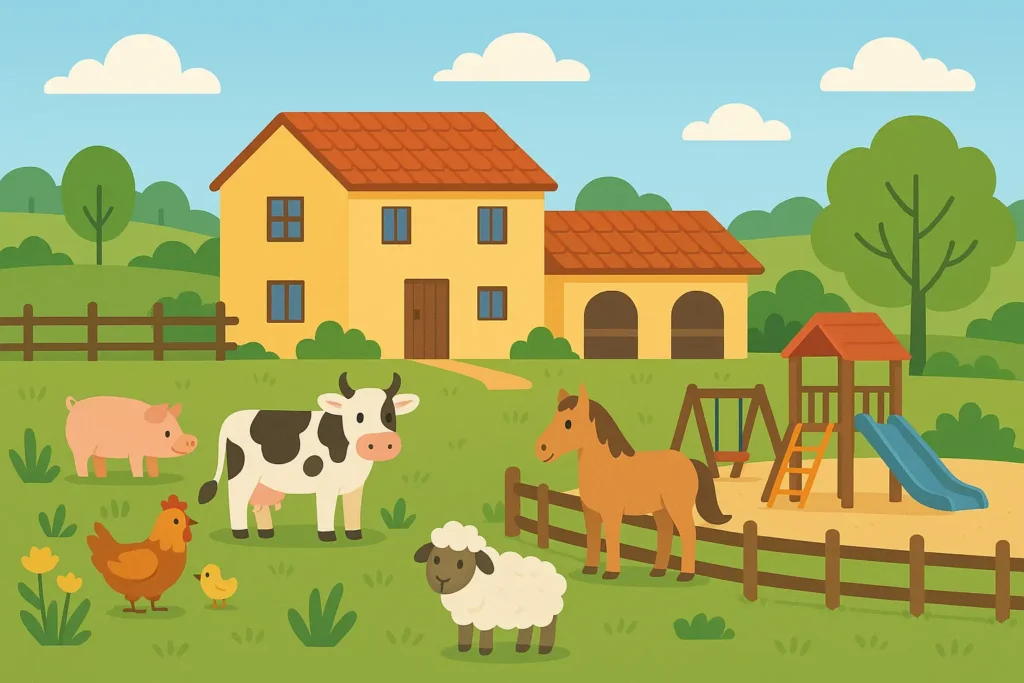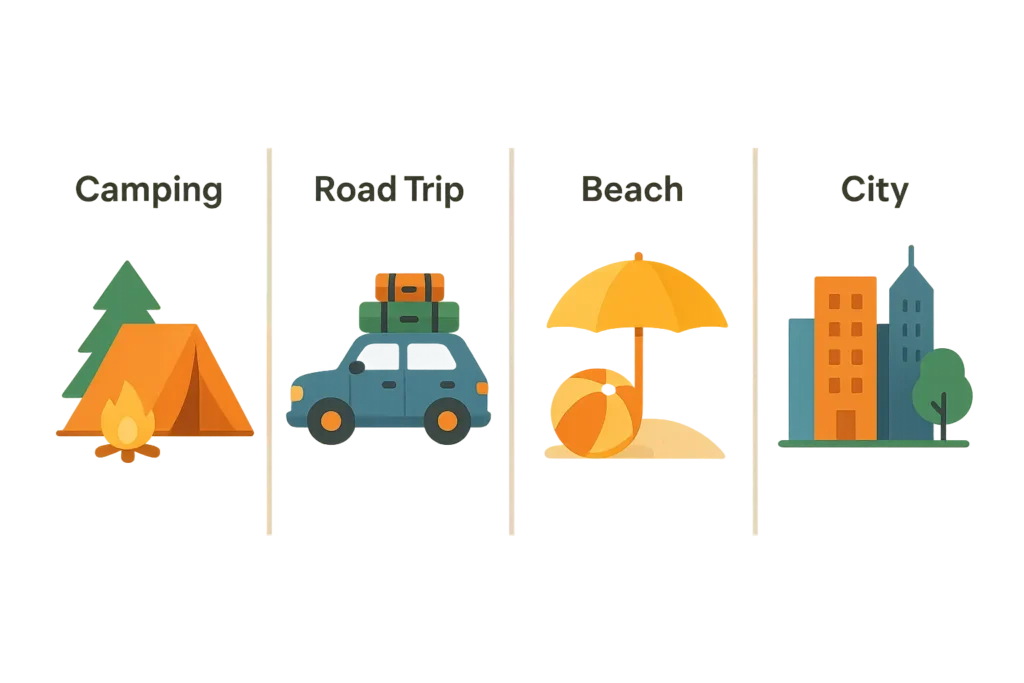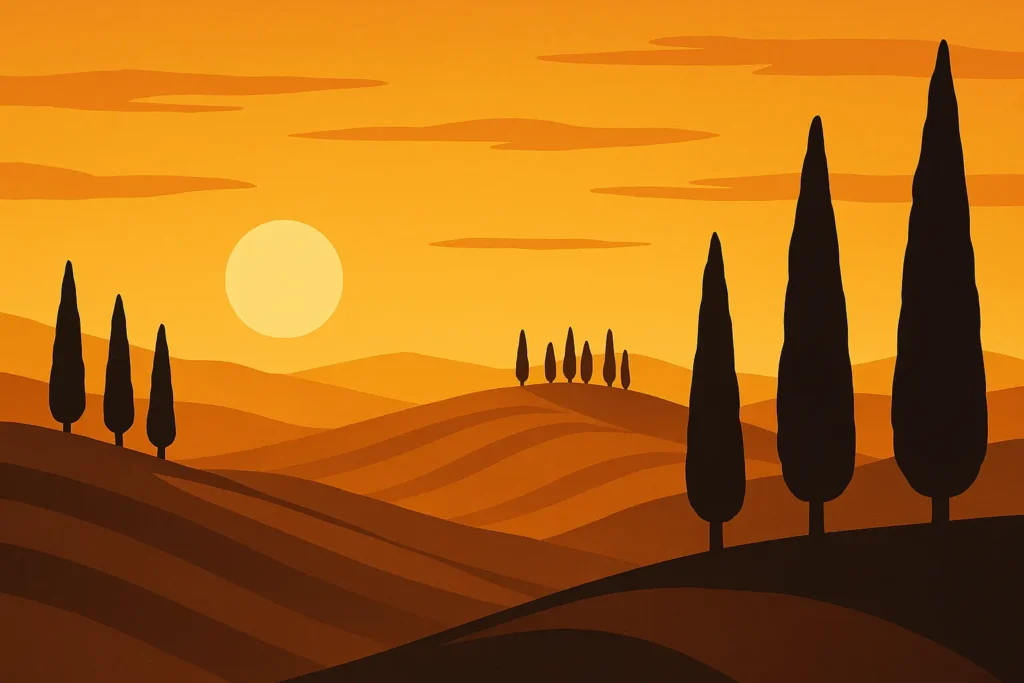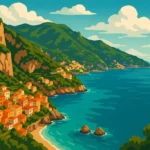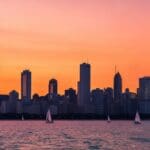I remember staring at my first Tuscany guidebook at 2 AM, completely overwhelmed and second-guessing every decision. Should I stay in Florence or venture into wine country? How many hill towns is too many? And why does everyone make it sound so easy when I’m over here stress-eating gelato while trying to figure out train schedules?
Look, I get it – planning the perfect tuscany itinerary can feel like you need a PhD in Italian geography. According to Rick Steves’ travel expertise, most travelers benefit from structured itineraries that prioritize geographic proximity and realistic timeframes, with 8-day trips allowing for deeper exploration beyond Florence and Siena. That’s exactly why I put together these 25 itineraries – they’re based on real trips I’ve taken (and mistakes I’ve made) so you don’t have to figure it out the hard way.
Quick Resources:
-
Plan your romantic adventure with our Honeymoon Planner
-
See the full suite of planning tools with our All Wedding Tools
This guide isn’t some fancy marketing brochure – it’s honest advice from someone who’s gotten lost in Tuscan hill towns, accidentally ordered horse meat thinking it was beef, and learned that “rustic charm” sometimes means “the shower pressure is terrible.” Whether you’re planning a romantic honeymoon, trying to keep kids entertained, or just want to drink really good wine without breaking the bank, I’ve got an itinerary that actually works.
Plan your romantic Tuscan honeymoon with our Honeymoon Planner
TL;DR
- 25 detailed tuscany itineraries that actually work, from budget backpacking to “money’s no object” luxury
- First-timer routes focus on the classics – Florence, Siena, and those Instagram-worthy hill towns (4-7 days)
- Wine and food trips dive deep into Chianti, Brunello, and hands-on cooking (expect to gain weight)
- Hidden gem adventures take you where tour buses can’t go – but you’ll need a rental car and good GPS
- Active itineraries include cycling, hiking, and adventure sports (pack good shoes, seriously)
- Luxury options feature castle hotels and private jets (because why not dream big?)
- Family-friendly tours keep everyone happy (translation: lots of gelato breaks)
- Some trips need rental cars, others work with public transit – I’ll tell you which is which
- Timing matters – harvest season is magical but book ahead, summer is hot but gorgeous
- Budget ranges from hostel-friendly to “I just won the lottery” – there’s something for everyone
Planning Your Perfect Tuscany Experience (Without Losing Your Mind)
Before you start booking flights and accommodations, let’s get real about what you actually want from this trip. I’ve seen too many people try to cram everything into one visit and end up stressed instead of relaxed. Here’s how to figure out what kind of Tuscan adventure will make you happiest.
How Long Do You Actually Have? (Be Honest)
Your trip length determines everything, and I mean everything. Don’t be that person who tries to see all of Tuscany in three days – you’ll spend more time in trains than actually enjoying yourself.
Short trips (3-4 days) work best if you’re focusing on Florence with maybe one countryside day trip. I learned this the hard way when I tried to hit five hill towns in two days and ended up seeing them all from car windows. Medium trips (6-8 days) let you actually relax and enjoy both city and countryside without feeling rushed. Extended adventures (10+ days) are when you can really get off the beaten path and maybe even learn some Italian beyond “where’s the bathroom?”
| Trip Duration | What You Can Realistically Do | Transportation | Daily Budget Reality |
|---|---|---|---|
| 3-4 Days | Florence + one day trip | Public transit works | $150-300 (including that wine you’ll buy) |
| 5-7 Days | City + countryside combo | Mix of both | $200-400 (budget for extras) |
| 8-10 Days | Multiple regions, actual relaxation | Rental car recommended | $250-500 (those vineyard lunches add up) |
| 11+ Days | Hidden gems, slow travel | Rental car essential | $300-800 (or whatever you want) |
Here’s the thing about timing – spring (April-May) is gorgeous but pack layers because Tuscan weather has mood swings. I’ve been in shorts at lunch and shivering by dinner. Fall (September-October) is harvest season magic, but book ahead because everyone knows it’s the best time. Summer is hot – like really, really hot – but the long days and beach access make up for it. Winter focuses on cozy indoor experiences and truffle season, plus you’ll have places mostly to yourself.
What Actually Gets You Excited About Travel?
Be honest here. Are you the type who gets excited about spending three hours in a museum, or do you start checking your phone after 20 minutes? Do you want to learn about wine or just drink it? There’s no wrong answer, but knowing yourself saves you from booking the wrong trip.
Art lovers should plan for museum fatigue – even the Uffizi gets overwhelming. Food enthusiasts need to pace themselves because you’ll want to try everything. Outdoor types should know that some of those scenic hill towns involve serious uphill walking in the heat. And if you’re traveling with kids, accept that your 8-year-old will be bored with Renaissance paintings after about ten minutes, no matter how amazing they are.
Your accommodation choice changes everything too. Those Instagram-famous agriturismos are incredible but some are literally in the middle of nowhere. Like GPS-stops-working nowhere. If you’re not comfortable driving winding country roads in the dark, book something closer to town.
Let’s Talk Money (Because Nobody Likes Credit Card Surprises)
Budget planning for Tuscany is tricky because those €25 wine tastings can easily become €75 when you factor in the bottle you’ll definitely want to buy, plus lunch, plus transportation back to your hotel because you’re too tipsy to navigate cobblestones.
Rental cars give you freedom but add fuel costs, parking fees (good luck finding a spot in San Gimignano), and those mysterious traffic tickets that show up months later. Public transportation is cheaper but limits where you can go and requires schedule coordination – Italian trains are great until you need to get to a tiny hill town.
Here’s my honest take on costs: budget for 30% more than you think you’ll spend. That perfect Tuscan lunch overlooking vineyards? It’s worth every euro, but it adds up. Wine tastings, cooking classes, those ceramic pieces you’ll definitely buy in Montelupo – they’re all part of the experience, so plan accordingly.
Never Been to Tuscany? Start Here
These five itineraries are perfect for first-timers who want to see the highlights without feeling like they’re on a forced march through medieval streets. I’ve designed each one based on real feedback from travelers who’ve done these routes – including the mistakes to avoid and the moments that make it all worthwhile.
1. The Florence & Tuscany Essential (6 Days)
This is my go-to recommendation for first-timers who want a taste of everything. Days 1-3 cover Florence’s greatest hits – the Duomo (climb it early to avoid crowds), the Uffizi (book ahead or you’ll be waiting in line for hours), and Ponte Vecchio (gorgeous but packed with tourists). Day 3 includes a Pisa day trip because, let’s be honest, you can’t not see the leaning tower.
Days 4-5 take you to Siena (that shell-shaped piazza is even more beautiful in person) and San Gimignano (yes, it’s touristy, but those towers are incredible). Day 6 explores Chianti wine country, where you’ll finally understand what all the fuss is about. This tuscany itinerary gives you the perfect introduction without overwhelming you.
Real Talk About Day 3 – Florence to Pisa:
- 8:00 AM: Catch the train (buy tickets in advance, trust me)
- 9:30 AM: Piazza dei Miracoli – yes, it’s as tilted as it looks in photos
- 12:00 PM: Lunch at a local place (avoid the tourist traps near the tower)
- 2:00 PM: Cathedral and Baptistery (underrated but beautiful)
- 4:00 PM: Wander Pisa’s real neighborhoods – much more authentic
- 6:00 PM: Train back to Florence
- 8:00 PM: Dinner in Oltrarno – my favorite Florence neighborhood
Pro tip: Book that tower climb in advance or you’ll be stuck taking photos from the ground like I was on my first visit. Learn from my mistakes.
2. The Tuscan Triangle (5 Days)
Perfect for people who want maximum impact in minimum time. Days 1-2 focus on Florence essentials, Days 3-4 cover Siena’s medieval magic, and Day 5 combines Pisa and Lucca. This route works great with public transportation, so you don’t need to stress about Italian driving.
The beauty of this tuscany travel itinerary is that it’s practically foolproof – trains connect all these cities reliably, and each destination has enough to keep you busy without overwhelming you.
3. Hill Towns That’ll Make Your Instagram Jealous (7 Days)
This one’s for people who’ve seen those cypress-lined road photos and need to experience them in person. Days 1-2 explore Montepulciano (great wine, stunning views) and Pienza (tiny but perfect, famous for cheese). Days 3-4 hit San Gimignano and Volterra – one’s all about those medieval towers, the other has incredible Etruscan history.
Days 5-6 bring you to Cortona (yes, like in “Under the Tuscan Sun”) and Day 7 ends in Montalcino for some of Italy’s best wine. Fair warning: this route requires a rental car and some of these towns involve serious uphill walking. Wear good shoes.
4. Art Lover’s Dream (6 Days)
If you’re the type who can spend hours in museums without getting antsy, this one’s for you. Days 1-3 dive deep into Florence’s art scene – Uffizi, Accademia, Palazzo Pitti, plus hidden gems like the Brancacci Chapel that most tourists miss.
Day 4 takes you to Arezzo specifically for Piero della Francesca’s incredible frescoes (worth the trip alone). Days 5-6 explore Siena’s Gothic masterpieces. This is a focused cultural immersion that art enthusiasts absolutely love.
5. Quick Tuscany Sampler (4 Days)
For people with limited time who still want to say they “did” Tuscany. Days 1-2 hit Florence’s absolute must-sees, Day 3 is a Siena day trip, and Day 4 combines Pisa with departure logistics. It’s fast-paced but doable, and you’ll get those classic Tuscan experiences. Perfect for couples planning intimate celebrations – this condensed format works great for elopement planning combined with your Tuscan adventure.
Customize your dream honeymoon with our Honeymoon Planner
Wine & Food Adventures That Won’t Disappoint
Let’s be honest – half the reason you’re considering Tuscany is for the wine and food, right? These five itineraries are designed for people who consider a good meal and perfect wine pairing to be the highlight of any day. Fair warning: you will gain weight, you will buy more wine than you can carry home, and you will not regret any of it.
6. The Ultimate Wine Tour (8 Days)
This is for serious wine lovers who want to understand what makes Tuscan wine special. Days 1-2 immerse you in Chianti Classico around Greve and Castellina – you’ll stay at actual wine estates and taste wines that never make it to export markets.
Days 3-4 focus on Montalcino’s legendary Brunello wines. That first sip of properly aged Brunello? Life-changing. Days 5-6 explore Montepulciano’s Vino Nobile, and Days 7-8 finish in Bolgheri for those famous Super Tuscans. You’ll need a designated driver or private transportation because responsible wine tasting involves a lot of wine.
| Wine Region | What Makes It Special | Reality Check | Tasting Costs |
|---|---|---|---|
| Chianti Classico | The classic red you know and love | Can get crowded in summer | €25-75 per person |
| Montalcino | Brunello – Italy’s most prestigious wine | Expensive but worth it | €40-120 per person |
| Montepulciano | Vino Nobile – elegant and food-friendly | Beautiful hilltop setting | €20-60 per person |
| Bolgheri | Super Tuscans – the rebels of Italian wine | Coastal location, different vibe | €50-200 per person |
7. Cooking Classes & Market Tours (7 Days)
This is hands-on food immersion. Days 1-2 start in Florence with cooking classes and guided market tours – you’ll learn to pick the best ingredients and understand why Italians are so particular about their food.
Days 3-4 move to Chianti for farm-to-table experiences at working agriturismos. You’ll make pasta from scratch, learn about olive oil production, and eat meals that make you question every Italian restaurant back home. Days 5-6 take you to Lucca for different regional specialties, and Day 7 explores coastal cuisine that most tourists never experience.
8. Harvest Season Magic (10 Days)
September-October timing gets you access to experiences that don’t exist the rest of the year. Days 1-3 feature actual grape harvest participation in Chianti – you’ll pick grapes, crush them with your feet (yes, really), and celebrate with harvest meals that go until midnight.
Days 4-6 explore Montalcino during wine festival season. Days 7-8 shift to olive harvest in Maremma, and Days 9-10 include truffle hunting in San Miniato. This trip requires specific timing but delivers experiences you literally can’t get any other time of year.
What a Real Harvest Day Looks Like:
- 7:00 AM: Traditional harvest breakfast with the family
- 8:00 AM: Get your basket and learn proper grape-picking technique
- 8:30 AM – 12:00 PM: Pick grapes alongside locals (harder work than it looks)
- 12:00 PM: Harvest lunch under the olive trees (this meal alone is worth the trip)
- 2:00 PM: Tour the cellars and learn about fermentation
- 4:00 PM: Optional grape stomping (touristy but fun)
- 6:00 PM: Aperitivo with estate wines
- 8:00 PM: Harvest celebration dinner that goes late into the night
9. Slow Food & Local Producers (6 Days)
This focuses on traditional food producers and authentic local markets. Day 1 starts at Florence’s Sant’Ambrogio Market – the real one locals use, not the touristy San Lorenzo. Days 2-3 explore Pienza’s famous pecorino cheese makers, with behind-the-scenes access to aging caves.
Days 4-5 venture to Norcia area for traditional charcuterie, and Day 6 combines everything in a final cooking class. You’ll meet actual producers, understand traditional techniques, and taste things that never make it to restaurants.
10. Wine & Wellness Combo (5 Days)
Because sometimes you want to drink great wine and feel healthy about it. Days 1-2 combine Chianti vineyard visits with spa treatments at luxury wine estates. You’ll taste wines, then get massages among the vines.
Days 3-4 feature Saturnia’s natural hot springs combined with Maremma wine discoveries. Day 5 concludes at Montecatini Terme’s historic wellness facilities. This perfect balance of indulgence and rejuvenation appeals to travelers who want both great wine and relaxation.
Hidden Gems & Places Your Friends Haven’t Been
These five adventures take you where tour buses can’t go and Instagram hasn’t ruined yet. Fair warning: you’ll need a rental car, good GPS (download offline maps!), and a sense of adventure. But you’ll also get bragging rights and photos that’ll make your friends jealous.
11. Hidden Tuscany Discovery (9 Days)
This is for people who want to feel like they’ve discovered secret places. Days 1-2 explore Massa Marittima’s medieval streets and nearby Etruscan ruins at Populonia. You’ll meet local artisans still practicing traditional crafts and eat at restaurants that don’t have English menus.
Days 3-4 bring you to Pitigliano – the “Little Jerusalem” carved into tufa cliffs. It’s dramatic, historic, and most tourists have never heard of it. Days 5-6 venture into Garfagnana’s mountain valleys for hiking and chestnut processing demonstrations. Days 7-8 explore Lunigiana’s castle network, and Day 9 concludes with Carrara marble quarries where Michelangelo sourced his stone.
This comprehensive tuscany italy itinerary requires patience and flexibility, but rewards you with authentic experiences you can’t get anywhere else.
12. Wild Maremma Coast (6 Days)
Tuscany’s untamed southern coast offers dramatic landscapes and pristine beaches most visitors never see. Days 1-2 base in Grosseto for natural park exploration and wildlife watching. Days 3-4 explore Porto Ercole and the Argentario peninsula’s rugged beauty.
Days 5-6 combine thermal springs with Etruscan archaeological sites. This route shows you Tuscany’s wild side – literally. You’ll see flamingos, ancient ruins, and beaches that feel completely undiscovered.
13. Northern Mountains & Marble (7 Days)
The Apuan Alps reveal Tuscany’s mountainous character that most people never experience. Days 1-2 focus on Garfagnana valley hiking with mountain lodge stays. Days 3-4 explore Carrara’s marble quarries – these are active industrial sites, not tourist attractions, but they’re incredible.
Days 5-6 venture near the Cinque Terre border for coastal mountain combinations. Day 7 concludes in Lunigiana’s medieval villages. This distinctive tuscany itinerary showcases the region’s alpine character that completely contradicts the rolling hills stereotype.
14. Ancient Etruscan Trail (8 Days)
For history nerds who want to understand the civilizations that came before Rome. Days 1-2 begin in Volterra with extensive museum visits and nearby archaeological sites. Days 3-4 explore Populonia’s coastal Etruscan settlements.
Days 5-6 venture to Pitigliano and Sovana for cliff-carved tombs and ancient road networks. Days 7-8 conclude in Chiusi with underground tomb visits. This educational journey appeals to travelers who get excited about archaeology and ancient history.
15. Artist Residency Experience (14 Days)
Two weeks of creative immersion that goes way beyond typical tourism. Week 1 establishes Florence as your base with daily art classes and studio visits. You’ll connect with contemporary artists and learn techniques in various mediums.
Week 2 rotates through hill towns for plein air painting sessions, capturing the landscapes that inspired Renaissance masters. Throughout both weeks, you’ll participate in local art events and build lasting connections with Tuscany’s creative community. For artistic couples planning their own creative celebration, unique wedding gifts inspired by Tuscan artisan traditions can commemorate both your artistic journey and your union.
Active Adventures for the Outdoorsy Types
Four itineraries for people who can’t sit still and think the best way to see Tuscany is by bike, on foot, or while getting your adrenaline pumping. Pack good shoes, bring layers, and prepare for some of the most rewarding views you’ll ever earn through physical effort.
16. Cycling Through Wine Country (8 Days)
Pedal-powered exploration reveals details you’d never notice from a car window. Days 1-2 cycle from Florence into Chianti’s rolling hills – e-bikes are available if you’re not ready for those climbs (no shame, those hills are steep). Luggage transfer services mean you only carry a daypack.
Days 3-4 feature the Siena to San Gimignano route through medieval landscapes. Days 5-6 explore Val d’Orcia’s UNESCO World Heritage cycling paradise – those cypress-lined roads look even better when you’ve earned the view. Days 7-8 conclude with coastal cycling toward Pisa.
This active tuscany travel itinerary combines physical challenge with incredible scenery, plus you’ll feel less guilty about all that wine and pasta.
17. Walking the Via Francigena (10 Days)
This ancient pilgrimage route connects you with centuries of travelers who walked these same paths. Days 1-2 begin the San Miniato to San Gimignano section – it’s challenging but manageable. Days 3-4 approach Siena through traditional pilgrimage paths with pilgrim hostels and international walking community.
Days 5-7 traverse the stunning Val d’Orcia section – considered the route’s most beautiful part. Days 8-10 continue toward the Lazio border. You’ll meet fellow pilgrims from around the world and experience a different kind of travel entirely.
What a Real Pilgrim Day Looks Like:
- 6:00 AM: Early breakfast with other walkers from around the world
- 7:00 AM: Start walking with just a daypack (luggage transported separately)
- 7:30 AM – 12:00 PM: Morning section through countryside (12-15km)
- 12:00 PM: Lunch in a small village – simple but satisfying
- 1:30 PM – 5:00 PM: Afternoon section to your destination (8-12km)
- 5:30 PM: Arrive, shower, rest those feet
- 7:00 PM: Pilgrim dinner with your new international friends
- 8:30 PM: Early to bed because tomorrow you walk again
18. Adventure Sports & Adrenaline (6 Days)
For people who think hiking is too tame. Days 1-2 feature rock climbing in the Apuan Alps with professional guides. Days 3-4 shift to mountain biking through Maremma’s challenging trails.
Days 5-6 include via ferrata climbing routes and canyoning adventures. All activities include professional instruction and safety equipment, making extreme sports accessible to intermediate fitness levels. This high-energy tuscany itinerary appeals to adventure enthusiasts who want their hearts pumping.
19. Wellness & Yoga in Nature (7 Days)
Gentle activity combined with deep relaxation for holistic rejuvenation. Days 1-3 feature yoga retreat programming in Chianti hills with meditation, healthy cuisine, and vineyard walks. Days 4-5 explore Tuscany’s thermal springs circuit – Saturnia, Bagno Vignoni, and others.
Days 6-7 conclude with comprehensive spa treatments and final meditation sessions. This restorative approach balances activity with relaxation, perfect for people who want to return home actually refreshed rather than exhausted.
Luxury Escapes (When Money’s No Object)
Three ultra-premium itineraries for when you want the absolute best Tuscany has to offer. These aren’t just expensive – they’re exclusive, personalized, and designed to create memories that justify the price tag. If you have to ask how much they cost, they’re probably not for you.
20. Ultimate Honeymoon Experience (7 Days)
Romance perfected through luxury details and exclusive access. Days 1-2 begin at Florence’s Four Seasons with private museum tours, exclusive after-hours access, and dinners at Michelin-starred restaurants. Days 3-4 continue at Castello del Nero in Chianti with couple’s spa treatments and private wine tastings.
Days 5-7 conclude at Rosewood Castiglion del Bosco in Montalcino with helicopter tours, private chef experiences, and sunset aperitivos overlooking vineyard estates. Every detail is handled by personal concierges who anticipate your needs before you voice them.
Design your luxury honeymoon with our Honeymoon Planner
21. Castle Hotels & Historic Villas (10 Days)
Live like aristocracy in authentic historic properties. Days 1-3 begin at Castello di Casole with private estate tours and exclusive cellar access. Days 4-6 continue at Borgo Santo Pietro with organic farm experiences and world-class spa facilities.
Days 7-10 conclude at Villa San Michele in Fiesole with legendary service and panoramic Florence views. Each property offers unique luxury amenities while maintaining historical authenticity. For couples planning their own castle celebration, professional wedding planning services can coordinate luxury venue logistics while you focus on enjoying the aristocratic experience.
Create your own fairytale with our Honeymoon Planner
22. Private Jet & Ultimate Exclusivity (5 Days)
When convenience and privacy matter more than budget. Day 1 features private jet arrival with immediate luxury hotel check-in and personalized city exploration. Days 2-3 include helicopter wine tours with exclusive vineyard access.
Days 4-5 conclude at private villa accommodations with dedicated chef and staff services. Private aviation handles all transportation while personal staff anticipate every need. This represents the absolute pinnacle of luxury travel.
Family & Special Needs Tours
Three specialized itineraries that accommodate specific requirements while maintaining authentic Tuscan experiences. These aren’t watered-down versions – they’re thoughtfully adapted to ensure everyone enjoys the journey.
23. Family Adventures That Actually Work (8 Days)
Real talk: traveling with kids in Tuscany isn’t all Instagram moments. Days 1-2 explore Florence through family-friendly museums with shorter visits and interactive exhibits, plus mandatory gelato breaks every hour. Days 3-4 visit Siena and San Gimignano with stroller-friendly routes and playground stops.
Days 5-6 feature agriturismo stays with farm animals, swimming pools, and outdoor space where kids can actually run around. Days 7-8 conclude with beach time at Castiglione della Pescaia because sometimes everyone just needs to decompress. Accept that some days will be more about keeping everyone happy than cultural enlightenment.
24. Senior-Friendly Comfort (6 Days)
Accessible experiences that minimize walking while maximizing cultural immersion. Days 1-2 feature Florence exploration with private guides and comfortable transportation – no crowded walking tours or endless museum marathons. Days 3-4 include Chianti wine tours conducted entirely by car with minimal walking.
Days 5-6 conclude with thermal spa experiences providing relaxation and therapeutic benefits. All accommodations feature elevator access and comfortable amenities while maintaining authentic Tuscan character.
25. Photography Workshops (9 Days)
Structured around optimal lighting and phot ogenic locations for serious photographers. Days 1-3 focus on Florence architecture and street photography with professional instruction. Days 4-6 explore Val d’Orcia’s landscape photography opportunities during golden hour sessions.
Days 7-9 combine coastal and hill town variety for diverse subjects and lighting conditions. Professional photographers provide daily instruction while locations are selected for maximum visual impact and learning opportunities.
The Real Deal: What Two Premium Trips Actually Look Like
Let me break down exactly what you get (and what you don’t) with two of the most popular complex itineraries. No marketing fluff – just honest details about what your days actually look like and what you’ll spend your money on.
The Ultimate Wine Tour (8 Days) – What Really Happens
Days 1-2: Chianti Reality Check
You’ll stay at Castello di Verrazzano, which sounds fancy until you realize it’s a working farm where roosters wake you at dawn. The private tasting at Antinori includes wines you can’t buy anywhere else, but you’ll also spend €150 on bottles because how can you not?
That cooking class in Greve? You’ll make pasta from scratch while slightly tipsy from morning wine tastings, and it’ll be one of the best meals of your life. The sunset aperitivo at Castello di Volpaia is Instagram-perfect, but the drive there involves narrow roads that’ll test your rental car skills.
Days 3-4: Montalcino’s Brunello Scene
Rosewood Castiglion del Bosco is actual luxury – the kind where they remember your coffee preferences. The Biondi-Santi cellar tour costs €120 per person but you’re tasting wines that are literally historic. That vertical tasting of different Brunello vintages? It’s educational and expensive and totally worth it.
The vineyard picnic sounds romantic until you realize you’re eating in 95-degree heat because it’s August. Learn from my mistake – spring and fall are better for outdoor dining.
Days 5-6: Montepulciano’s Underground Secrets
Those underground cellars at Contucci are cool (literally – great escape from summer heat) and the wine is fantastic. The Pienza cheese pairing is where you’ll discover that good pecorino is nothing like what you get at home.
That Val d’Orcia photography session? You’ll take 200 photos to get one perfect shot, and it’ll be worth every attempt.
Days 7-8: Bolgheri’s Coastal Sophistication
Ornellaia and Sassicaia tastings are expensive (€100+ per person) but these are wines that sell for $300+ per bottle back home. The coastal setting is completely different from inland Tuscany – more refined, less rustic.
That final dinner at Gambero Rosso? It’s Michelin-level cuisine with prices to match, but after a week of incredible wines, you deserve it.
Hidden Tuscany Discovery (9 Days) – The Unvarnished Truth
Days 1-2: Massa Marittima & Real Local Life
You’ll stay in the historic center where parking is a nightmare but walking to everything is easy. The Etruscan sites at Populonia are fascinating if you’re into archaeology, but there’s minimal shade and lots of walking on uneven ground.
Those artisan workshops? You’ll meet people who’ve been practicing their craft for decades and barely speak English, but their passion translates. The restaurants don’t have English menus, but pointing and smiling works surprisingly well.
Days 3-4: Pitigliano’s Dramatic Beauty
The drive to Pitigliano is stunning but involves mountain roads that make some passengers carsick. The “Little Jerusalem” Jewish quarter is genuinely moving and historically significant, but it’s also quite small – you can see it all in a couple hours.
The tufa stone accommodations are unique and atmospheric, though “rustic charm” sometimes means quirky plumbing and thin walls.
Days 5-6: Mountain Adventures in Garfagnana
The mountain lodge experience is authentic but basic – think hiking hostel, not luxury resort. The chestnut processing demonstration is fascinating cultural education that most tourists never experience.
Those hiking trails offer incredible views but require good fitness and proper shoes. GPS becomes unreliable, so download offline maps and bring a backup battery.
Days 7-8: Lunigiana’s Castle Network
Castle-hopping sounds romantic until you realize many are ruins with limited facilities. The testaroli pasta workshop teaches you techniques that haven’t changed in centuries, but it’s not Instagram-pretty cooking – it’s real, traditional food preparation.
Day 9: Carrara Marble Finale
The quarry tours are industrial tourism at its best – dramatic, educational, and completely different from typical sightseeing. The sculptor workshops let you try working with marble, but expect to be terrible at it initially (and love it anyway).
Which Trip is Right for You? (Honest Assessment Time)
Choosing the wrong itinerary can turn your dream vacation into a stressful slog through tourist sites. Here’s my honest assessment system to help you pick the right adventure based on what you actually want (not what you think you should want).
Time Reality Check
Short Trips (4-6 days) – What Actually Works:
The Quick Tuscany Sampler (#5) and Tuscan Triangle (#2) are your best bets. Don’t try to cram in wine country – you’ll spend more time driving than enjoying. Florence plus one countryside day trip is realistic. Family trips (#23) work well short because kids get overwhelmed anyway.
Medium Trips (7-10 days) – The Sweet Spot:
This is where wine tours (#6-10) and hill town adventures (#3) really shine. You have time to actually relax instead of rushing between destinations. Active trips (#16-19) need this duration for recovery time between physical challenges.
Long Stays (10+ days) – When It Gets Really Good:
Artist residencies (#15), Via Francigena hiking (#17), and hidden gem discoveries (#11) need this time to develop meaningful connections and experiences. Luxury castle tours (#21) justify their costs through extended exclusive access.
Budget Reality (Let’s Be Honest About Money)
Budget-Conscious (Under €200/day):
Via Francigena pilgrimage (#17) uses hostel networks and is surprisingly affordable for extended travel. The Tuscan Triangle (#2) keeps transportation costs down with public transit. Hill towns (#3) feature reasonably priced agriturismos, but you’ll still need a rental car.
Mid-Range Sweet Spot (€200-400/day):
Florence & Tuscany Essential (#1) balances city hotels with countryside experiences without breaking the bank. Culinary tours (#7) provide hands-on experiences at moderate costs. Cycling adventures (#16) include equipment and luggage services at fair prices.
Luxury Territory (€400+/day):
Ultimate Wine Tour (#6) commands premium pricing but delivers exclusive access you can’t get elsewhere. Honeymoon packages (#20) justify costs through once-in-a-lifetime romantic experiences. Those castle hotels (#21)? Worth it if you can afford it.
Transportation Truths
You Absolutely Need a Car For:
Hidden gem discoveries (#11) – public transit doesn’t reach these places. Wine tours (#6-10) – you need safe transportation between tastings. Active adventures (#16-19) – equipment transport and schedule flexibility are essential.
Car Recommended But Not Essential:
Hill town circuits (#3) are much easier with a car, but determined travelers can use buses. Family tours (#23) are more convenient with your own transportation for kids and gear.
Public Transit Actually Works:
Florence-focused itineraries (#1, #4) have excellent urban connections. The Tuscan Triangle (#2) connects reliably by train and bus. Senior-friendly options (#24) can incorporate private guides with transportation included.
Group Dynamics That Actually Matter
Solo Travelers – What Really Works:
Artist residencies (#15) provide built-in creative communities. Photography workshops (#25) offer group learning with shared interests. Culinary classes (#7) create natural social interactions. That said, dinner alone can feel awkward in small towns – book group activities.
Couples – Romance vs. Reality:
Luxury honeymoon packages (#20) design everything around romantic connection. Wine retreats (#10) combine shared interests with relaxation. But be honest about your travel styles – if one of you hates wine, don’t book a wine-focused trip.
Families – Keeping Everyone Happy:
Family itineraries (#23) incorporate age-appropriate activities, but accept that your 8-year-old will be bored in the Uffizi after 20 minutes. Coastal combinations provide beach entertainment. Agriturismo stays offer farm animals and space to run around.
Friend Groups – Shared Adventures:
Cycling tours (#16) create group challenges and achievement experiences. Wine adventures (#6) facilitate celebrations and shared discoveries. Hidden gem explorations (#11) provide adventure bonding and unique stories.
Physical Reality Check
High Accessibility Needs:
Senior-friendly tours (#24) minimize walking through private transportation and careful planning. Luxury experiences (#20-22) provide full-service support eliminating physical challenges. Florence-focused trips utilize urban infrastructure and elevator access.
Moderate Activity Levels:
Classic tours (#1-5) require some hill town walking but offer flexible pacing. Wine regions (#6-10) feature manageable vineyard terrain with car-based transportation. Family options (#23) accommodate various ages through activity modifications.
Serious Physical Challenges:
Via Francigena hiking (#17) demands significant fitness and endurance. Adventure sports (#18) require intermediate to advanced abilities and risk tolerance. Remote discoveries (#11) involve challenging terrain and limited infrastructure.
Seasonal Timing Reality
Spring/Fall – Peak Performance:
Wine harvest tours (#8) require specific September-October timing for authentic experiences. Photography workshops (#25) benefit from optimal lighting and comfortable temperatures. Outdoor activities (#16-19) avoid extreme weather while maintaining comfort.
Summer – Hot but Manageable:
Coastal combinations (#12) provide valuable beach access during heat. Early morning scheduling helps avoid peak temperatures. Thermal springs (#10, #19) offer cooling contrast experiences. Just accept that you’ll be hot and plan accordingly.
Winter – Indoor Focus:
Cultural immersion (#4, #15) emphasizes museums and art during cooler months. Thermal spa retreats (#10, #19) provide warming experiences. Truffle season tours capitalize on November-March availability for unique culinary adventures.
Planning a destination wedding or honeymoon in Tuscany? The logistics can feel overwhelming – from navigating Italian requirements to coordinating with local vendors. That’s where Bridesmaid for Hire’s expertise becomes invaluable, providing stress-free wedding support that can extend to destination celebrations, ensuring your Tuscan dream unfolds perfectly.
Final Thoughts (And Why You’ll Love It Even When Things Go Wrong)
Look, I could give you 100 more tips about the perfect tuscany itinerary, but here’s the most important one: stuff will go wrong. You’ll get lost trying to find that “hidden gem” restaurant and end up at a gas station eating the best panino of your life. You’ll miss a train, order liver thinking it was chicken, or spend an entire day in Siena during siesta time when everything’s closed.
And you know what? Those usually make the best stories.
Tuscany is incredibly forgiving. The wine is good enough to make up for navigation failures. The food is so incredible that even your mistakes taste amazing. The scenery is so beautiful that getting lost just means discovering different gorgeous views. And the people are patient with tourists who butcher Italian pronunciation and point at menu items.
Your chosen itinerary should feel exciting, not overwhelming. If you’re constantly stressed about logistics, transportation, or meeting ambitious schedules, you’re missing the essence of Tuscan travel – the art of savoring life’s beautiful moments. Pick an itinerary that matches your natural pace and interests, then trust that Tuscany’s magic will fill in the details.
Some of my most treasured Tuscan memories happened when plans completely fell apart. That time I got lost in Chianti and discovered a family vineyard that’s not in any guidebook. The afternoon I missed my cooking class and ended up helping an elderly woman in Montalcino carry groceries, leading to an impromptu lesson in making ragu. The evening our rental car broke down in San Gimignano, forcing us to stay an extra day and discover the town after all the tour buses left.
These weren’t part of any tuscany travel itinerary, but they were the moments that made the trip unforgettable.
So choose your adventure, pack comfortable walking shoes (seriously, those cobblestones are unforgiving), download offline maps, learn how to say “please” and “thank you” in Italian, and prepare for an incredible experience. Whether you’re sipping Brunello while watching the sunset over Val d’Orcia, getting flour all over yourself in a cooking class, or simply wandering through medieval streets that haven’t changed in centuries, you’re going to create memories that last a lifetime.
Make those romantic moments last with our Honeymoon Planner
Tuscany has this amazing ability to exceed expectations, even when – especially when – things don’t go according to plan. Trust the process, embrace the chaos, and get ready for magic. You’ve got this.
For couples planning their own romantic Tuscan adventure, consider exploring honeymoon destinations that complement your chosen itinerary, creating seamless transitions from cultural exploration to intimate celebration in Italy’s most romantic region.
Build your perfect Italian honeymoon with our Honeymoon Planner
1-800-BRIDESMAID
The Newlywed
Card Game
something extra to love
Read the weekly newsletter from Bridesmaid for Hire, 1-800-Bridesmaid, to hear about real stories, from strangers, who need advice on love, life, friendship, and so much more.
Looking for the perfect wedding gift for someone you adore? Grab The Newlywed Card Game. It's a fun and interactive game they can play on their honeymoon or future date nights.
